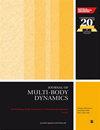下肢康复装置线性执行器的建模与控制
IF 1.9
4区 工程技术
Q3 ENGINEERING, MECHANICAL
Proceedings of the Institution of Mechanical Engineers Part K-Journal of Multi-Body Dynamics
Pub Date : 2023-08-10
DOI:10.1177/14644193231194122
引用次数: 0
摘要
近年来,中风患者的数量有所增加,这导致对运动康复锻炼的需求增加。自动化设备在患者康复中的应用日益发达。这些设备有助于减少患者的训练时间和工作量。每种类型的设备使用不同的执行器,如电动机,气动缸和液压缸。与以往的研究不同,本文提出了一种使用简单执行器的下肢康复装置的研究模型,即线性执行器。本研究的主要贡献是建立了与所研究模型的三自由度下肢运动动力学相关的线性作动器动力学模型。建立了该作动器的数学模型,利用MATLAB/Simulink软件对机构的响应进行了仿真。制作并测试了一种采用线性驱动器的下肢康复装置。对10名志愿者的测试结果表明,该驱动器工作正常,产生微小的角度误差。实验表明,该线性执行器可用于脑卒中患者康复设备,有助于自动化设备中机构的多样化。本文章由计算机程序翻译,如有差异,请以英文原文为准。
Modeling and control of the linear actuator for the lower limb rehabilitation device
In recent years, the number of stroke patients has increased, which has led to an increased need for motor rehabilitation exercises. The application of automation devices in the rehabilitation of patients is becoming increasingly developed. These devices help reduce the patient training time and workload. Each type of equipment uses different actuators such as electric motors, pneumatic cylinders, and hydraulic cylinders. Different from previous studies, in this paper, a research model of lower extremity rehabilitation devices using a simple actuator which is a linear actuator is presented. The main contribution of this study is that a dynamic model of the linear actuator associated with the action dynamics of the lower extremities of the studied model with three degrees of freedom was established. A mathematical model for this actuator is also presented, simulating the response of the mechanism using the MATLAB/Simulink software. A lower extremity rehabilitation device using a linear actuator was manufactured and tested. The test results for 10 volunteers show that the actuator works and causes miniature angle errors. This experiment demonstrates that the linear actuator can be used in stroke patient rehabilitation equipment and contributes to the diversification of the mechanism in automation equipment.
求助全文
通过发布文献求助,成功后即可免费获取论文全文。
去求助
来源期刊

CiteScore
4.10
自引率
11.10%
发文量
38
审稿时长
>12 weeks
期刊介绍:
The Journal of Multi-body Dynamics is a multi-disciplinary forum covering all aspects of mechanical design and dynamic analysis of multi-body systems. It is essential reading for academic and industrial research and development departments active in the mechanical design, monitoring and dynamic analysis of multi-body systems.
 求助内容:
求助内容: 应助结果提醒方式:
应助结果提醒方式:


